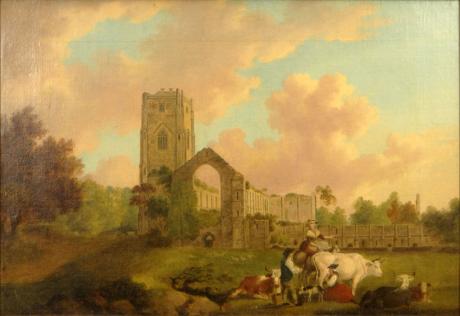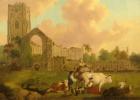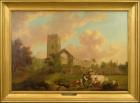Christies, 14th April 1950, Lot 1032, bt Manuadpour for £3.3.0 (3gns)
After a dispute and riot in 1132 at the Benedictine house, St Mary's Abbey, in York, 13 monks were expelled and, after unsuccessfully attempting to return to the early 6th-century Rule of St Benedict, were taken into the protection of Thurstan, Archbishop of York.He provided them with land in the valley of the River Skell, a tributary of the Ure. The enclosed valley had all the natural features needed for the creation of a monastery, providing shelter from the weather, stone and timber for building, and a supply of running water. After enduring a harsh winter in 1133, the monks applied to join the Cistercian order and in 1135 became the second house of that order in northern England, after Rievaulx. The monks subjected themselves to Clairvaux Abbey, in Burgundy which was under the rule of St Bernard. Under the guidance of Geoffrey of Ainai, a monk sent from Clairvaux, the group learned how to celebrate the seven Canonical Hours and were shown how to construct wooden buildings in accordance with Cistercian practice. After Henry Murdac was elected to the abbacy in 1143, the small stone church and timber claustral buildings were replaced. Within three years, an aisled nave had been added to the stone church, and the first permanent claustral buildings built in stone and roofed in tile had been completed. In 1146 an angry mob, displeased with Murdac's role in opposing the election of William FitzHerbert to the archbishopric of York, attacked the abbey and burnt down all but the church and some surrounding buildings.The community recovered swiftly from the attack and founded four daughter houses. Henry Murdac resigned the abbacy in 1147 to become the Archbishop of York and was replaced first by Maurice, Abbot of Rievaulx then, on the resignation of Maurice, by Thorald. Thorald was forced by Henry Murdac to resign after two years in office. The next abbot, Richard, held the post until his death in 1170 and restored the abbey's stability and prosperity. In 20 years as abbot, he supervised a huge building programme which involved completing repairs to the damaged church and building more accommodation for the increasing number of recruits. Only the chapter house was completed before he died and the work was ably continued by his successor, Robert of Pipewell, under whose rule the abbey gained a reputation for caring for the needy.The next abbot was William who presided over the abbey from 1180 to 1190 and he was succeeded by Ralph Haget, who had entered Fountains at the age of 30 as a novice, after pursuing a military career. During the European famine of 1194 Haget ordered the construction of shelters in the vicinity of the abbey and provided daily food rations to the poor enhancing the abbey's reputation for caring for the poor and attracting more grants from wealthy benefactors. In the first half of the 13th century Fountains increased in reputation and prosperity under the next three abbots, John of York (1203–1211), John of Hessle (1211–1220) and John of Kent (1220–1247). They were burdened with an inordinate amount of administrative duties and increasing demands for money in taxation and levies but managed to complete another massive expansion of the abbey's buildings. This included enlarging the church and building an infirmary. In the second half of the 13th century the abbey was in more straitened circumstances. It was presided over by eleven abbots, and became financially unstable largely due to forward selling its wool crop, and the abbey was criticised for its dire material and physical state when it was visited by Archbishop John Romeyn in 1294. The run of disasters that befell the community continued into the early 14th century when northern England was invaded by the Scots and there were further demands for taxes. The culmination of these misfortunes was the Black Death of 1349–1349. The loss of manpower and income due to the ravages of the plague was almost ruinous.A further complication arose as a result of the Papal Schism of 1378–1409. Fountains Abbey along with other English Cistertion houses was told to break off any contact with the mother house of Citeaux, which supported a rival pope. This resulted in the abbots forming their own chapter to rule the order in England and consequently they became increasingly involved in internecine politics. In 1410, following the death of Abbott Burley of Fountains, the community was riven by several years of turmoil over the election of his successor. Contending candidates John Ripon, Abbot of Meaux, and Roger Frank, a monk of Fountains were locked in discord until 1415 when Ripon was finally appointed and presided until his death in 1434. Under abbots John Greenwell (1442–1471), Thomas Swinton (1471–8), John Darnton (1478–95), who undertook some much needed restoration of the fabric of the abbey including notable work on the church, and Marmaduke Huby (1495–1526) Fountains regained stability and prosperity. When Marmaduke Huby died he was succeeded by William Thirsk who was accused by the royal commissioners of immorality and inadequacy and dismissed from the abbacy and replaced by Marmaduke Bradley, a monk of the abbey who had reported Thirsk's supposed offences, testified against him and offered the authorities six hundred marks for the abbacy. In 1539 Bradley surrendered the abbey when Henry VIII ordered the Dissolution of the Monasteries. The abbey precinct covered 70 acres (28 ha) surrounded by an 11-foot (3.4 m) wall built in the 13th century, some parts of which are visible to the south and west of the abbey. The area consists of three concentric zones cut by the River Skell flowing from west to east across the site. The church and claustral buildings stand at the centre of the precinct north of the Skell, the inner court containing the domestic buildings stretches down to the river and the outer court housing the industrial and agricultural buildings lies on the river's south bank. The early abbey buildings were added to and altered over time, causing deviations from the strict Cistercian type. Outside the walls were the abbey's granges. Construction began in 1132 when a two-storey wooden church was built under the oversight of Geoffrey of Clairvaux. A church built with locally quarried sandstone later replaced it. The original cruciform, unaisled stone church was badly damaged by fire in 1146 and rebuilt in enlarged form on the same site. This structure, completed around 1170, was 300-foot (91 m) long and had 11 bays in the side aisles. A lantern tower was added at the crossing of the church in the late 12th century. The presbytery at the eastern end of the church was much altered in the 13th century. The church's greatly lengthened choir, commenced by Abbot John of York, 1203–11, and carried on by his successor terminates, like that of Durham Cathedral, in an eastern transept, the work of Abbot John of Kent, 1220–47. The 160-foot (49 m) tall tower, which was added not long before the dissolution, by Abbot Huby, 1494–1526, is in an unusual position at the northern end of the north transept and bears Huby's motto 'Soli Deo Honor et Gloria'. The sacristry adjoined the south transept. The cloister, which had arcading of black marble from Nidderdale and white sandstone, is in the centre of the precinct and to the south of the church. The three-aisled chapter-house and parlour open from the eastern walk of the cloister and the refectory, with the kitchen and buttery attached, are at right angles to its southern walk. Parallel with the western walk is an immense vaulted substructure serving as cellars and store-rooms, which supported the dormitory of the conversi (lay brothers) above. This building extended across the river and at its southwest corner were the latrines, built above the swiftly flowing stream. The monks' dormitory was in its usual position above the chapter-house, to the south of the transept. Peculiarities of this arrangement include the position of the kitchen, between the refectory and calefactory, and of the infirmary above the river to the west, adjoining the guest-houses. The Abbey buildings and over 500 acres (200 ha) of land were sold by the Crown, on 1 October 1540, to Sir Richard Gresham, the London merchant, father of the founder of the Royal Exchange, Sir Thomas Gresham. Gresham sold some of the fabric of the site, stone, timber, lead, as building materials to help to defray the cost of purchase. The site was acquired in 1597 by Sir Stephen Proctor, who used stone from the monastic complex to build Fountains Hall. Between 1627 and 1767 the estate was owned by the Messenger family who sold it to William Aislaby who was responsible for combining it with the Studley Royal Estate. The archaeological excavation of the site was begun under the supervision of John Richard Walbran, a Ripon antiquary who, in 1846, had published a paper On the Necessity of clearing out the Conventual Church of Fountains. In 1966 the Abbey was placed in the guardianship of the Department of the Environment and the estate was purchased by the West Riding County Council who transferred ownership to the North Yorkshire County Council in 1974. The National Trust bought the 674-acre (273 ha) Fountains Abbey and Studley Royal estate from North Yorkshire County Council in 1983. In 1986 the parkland in which the abbey is situated and the abbey was designated a World Heritage Site by UNESCO. It was recognised for fulfilling the criteria of being a masterpiece of human creative genius, and an outstanding example of a type of building or architectural or technological ensemble or landscape which illustrates significant stages in human history. Fountains Abbey is owned by the National Trust and maintained by English Heritage. The trust owns Studley Royal Park, Fountains Hall, to which there is partial public access, and St Mary's Church, designed by William Burges and built around 1873, all of which are significant features of the World Heritage Site. The Porter's Lodge, which was once the gatehouse to the abbey, houses a modern exhibition area with displays about the history of Fountains Abbey and how the monks lived. In January 2010, Fountains Abbey and Studley Royal became two of the first National Trust properties to be included in Google Street View, using the Google Trike.
Ibbetson was born at Farnley Moor, Leeds. He was the second child of Richard Ibbetson, a clothier from Yorkshire. According to his Memoir, his mother fell on the ice and went into labor prematurely, causing him to be delivered by caesarean section and resulting in a middle name he attempted to hide throughout his life. Ibbetson was probably educated in a local Moravian community and then by Quakers in Leeds. According to James Mitchell in the Oxford Dictionary of National Biography, the "unusual thoroughness" of his education "is reflected in the fluent prose, both of his published painting manuals and of his regular, often entertaining, and rewarding correspondence with patrons". Ibbetson was apprenticed to John Fletcher, a ship painter in Hull, from 1772 to 1777. He then moved to London, where for the next ten years he was primarily a picture restorer for a Clarke of Leicester Fields. In 1782 wrote an account of his life and sent it to the artist Benjamin West which was transcribed by Joseph Farington in 1805. Around 1780, Ibbetson married his first wife, Elizabeth.
In 1785, Ibbetson began exhibiting at the Royal Academy with View of North Fleet. Mitchell calls George Biggin (1783), which is one of Ibbetson's earliest known works, "an accomplished full-length portrait in the Gainsborough tradition, [which] should be considered as a milestone in the development of an artist who was entirely self-taught".Through the efforts of Captain William Baillie in 1787, Ibbetson was made draughtsman to Colonel Charles Cathcart on the first British embassy to Peking (Beijing); he made many watercolor drawings of the animals and plants on the journey. While he was away, his Ascent of George Biggin, esq. from St. George's Fields, June 29th 1785was exhibited at the Royal Academy to great critical and popular acclaim.
In 1789, Ibbetson went to visit the Viscount Mountstuart at Cardiff Castle in Wales. He spent decades drawing the scenery there and, according to Mitchell, "is detailed watercolours of iron furnaces, coal staithes, and copper mines foreshadow the work of Joseph Wright of Derby and J. M. W. Turner and constitute an important record of the early industrial developments in that region, but are less well known than his more numerous scenes of folk life and picturesque scenery." After a visit to the Isle of Wight in 1790, he began painting shipwrecks and smugglers.David Murray, 2nd Earl of Mansfield, and his wife commissioned Ibbetson to decorate Kenwood House, in 1794. This distracted him from the death of his wife and caring for their three children. Her death had "provoked a minor nervous breakdown, exacerbated by near destitution", but the Kenwood project relieved that stress. Four years later, he moved to Liverpool to work for Thomas Vernon. In 1801 he married his second wife, Bella Thompson, and moved to Ambleside.
Ibbetson acquired several generous patrons in Liverpool and in Edinburgh: William Roscoe, Sir Henry Nelthorpe, and the Countess of Balcarress. The last prompted him to write and publish his instruction manual An Accidence, or Gamut, of Painting in Oil (1803). In 1803, he met the Yorkshirephilanthropist William Danby and in 1805 moved to Masham to be near him. The next 14 years of his life were the most settled of his life.
Ibbetson died on 13 October 1817 and was buried in the churchyard of St Mary's, Masham. Benjamin West described Ibbetson as the "Berchem of England" in recognition of his debt to the Dutch 17th century landscape painters. According to Mitchell, "his watercolours are prized for their delicacy and sureness of line". Many were engraved for projects such as John Church's A Cabinet of Quadrupeds and John Boydell's Shakespeare Gallery. Samuel Haslem Scott described him as "a portly, jovial person".



